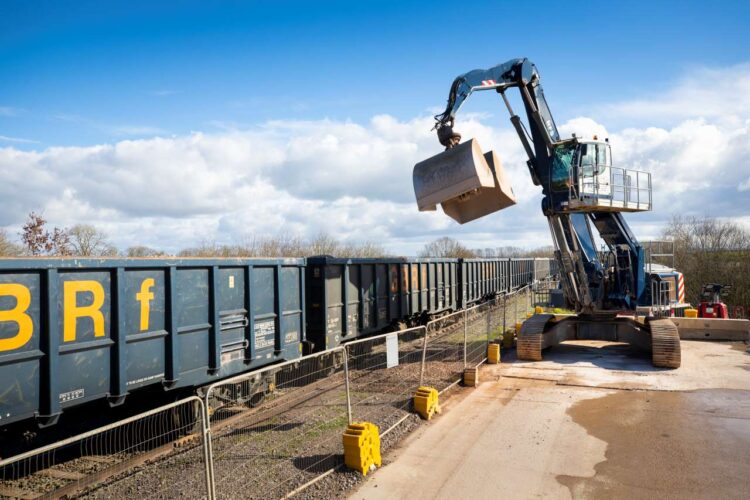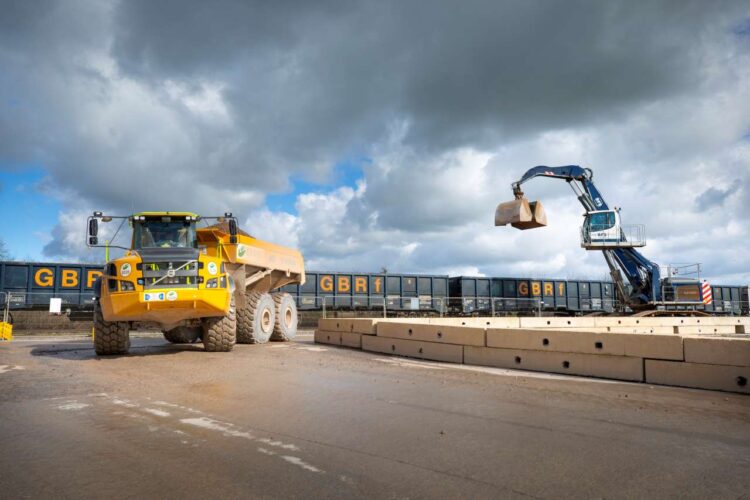It has been revealed that over one million tonnes of railway construction materials have been delivered to the rail construction hub set up near Quainton.
The work involved is in the building of HS2. So far a total of 646 trains have taken materials to the site.
With works still on going in the construction of HS2 it is estimated 1,400 more freight trains are due to arrive at the Quainton railhub over the next two years, thus increasing the amount of materials being brought to be in the region of over three million tonnes in total.
By bringing materials in by rail it has helped enormously in offsetting carbon emissions, it has helped to keep 217,000 HGVs off the local roads, particularly in Buckinghamshire, Oxfordshire and West Northamptonshire.

This in turn has saved over 22,378 tonnes of carbon being released into the atmosphere, which is the equivalent to 22,300 single passenger flights between London and New York.
These numbers also include over a million tonnes of materials that were already delivered to previous rail hubs in the area, meaning that so far, overall two million tonnes of materials have been delivered.
Most of the materials delivered so far consist of aggregates which is used for foundation and stabilisation work.
This is stockpiled in the Quainton area before being moved to the building sites to the north or south of the High Speed route for use in foundation of the track bed.
As no trains currently run on this section of HS2 as its yet to be connected to other parts of the line, a network of haul roads used by dumper trucks keep the traffic moving and away from the local roads in the area.

Things are moving at a pace with the building of HS2, with it being forecast that the peak of the construction works is due to be reached in the coming months.
Once complete journey times between London and Birmingham will take just under half of what they currently are on the West Coast Mainline.
This in turn will also free up space for additional local services and more reliable intercity services on the West Coast Mainline.
HS2 Ltd Senior Project Manager Ben Sebastian-Green said: “We know that the local community are concerned about construction traffic, so it’s great to be able to get so much material into site by rail. Not only does it take traffic off local roads, but it also saves carbon and helps to streamline our logistics. Once complete, HS2 will improve journeys between London and Birmingham and free up space on the existing West Coast Mainline for more local services – and it’s great that, alongside delivering zero carbon journeys for passengers, we’re also cutting the amount of carbon in construction. The railhead is managed by HS2’s main works contractor EKFB – a team made up of Eiffage, Kier, Ferrovial Construction and Bam Nuttall. EKFB are delivering the central section of the project, including 15 viaducts, 81 bridges and two ‘green tunnels’. They worked with a team from Network Rail who completed a series of alterations to enable freight services to operate in and out of the railhead at Quainton.
EKFB’s Head of Logistics and Security, Paul Bedford, said: “Moving material by rail was always an essential part of our strategy to help deliver this project efficiently. The original strategy was to utilise existing railheads across neighbouring counties and move the material the last few miles to site by road. We quickly realised that there was an opportunity to establish our own railheads within the project area, and through the hard work of all involved, we turned this opportunity into a reality. The railheads are now taking large volumes of HGVs off the local road network, reducing our carbon footprint through fewer road journeys, and helping to generate significant financial savings by using a more cost-effective distribution system. The railhead is operated by Fishbone Solutions on behalf of EKFB with trains operated by DC Rail and GB Railfreight on behalf of Hanson.
Director at Fishbone Logistics, Paul Clews, commented: “What started with an initial trial of 100,000 Tonnes to the first railhead at Calvert North, the support and cooperation from EKFB, HS2, the quarry and the rail logistics supply partners, to deliver the two millionth ton to the fourth railhead at Quainton Road, has been a fantastic collaborative effort. Zero safety incidents, reduced carbon and transport costs, and more than 200,000 truck journeys taken off local roads is a great achievement by all involved.”





Responses
Will the track be relaid back to Claydon junction and are the sidings being laid at Greatmoor energy from waist
All very commendable but do your figures take into account the carbon omissions resulting from the manufacture of all these materials for a railway which will have no benefit for people like me who live in Northumberland????